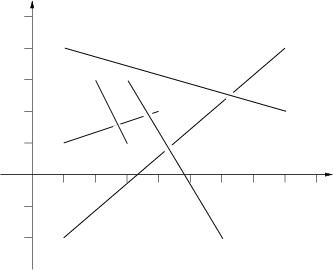POJ 2653 Pick-up sticks (判断线段相交)
Pick-up sticks
| Time Limit: 3000MS | Memory Limit: 65536K | |
| Total Submissions: 10241 | Accepted: 3795 |
Description
Stan has n sticks of various length. He throws them one at a time on the floor in a random way. After finishing throwing, Stan tries to find the top sticks, that is these sticks such that there is no stick on top of them. Stan has noticed that the last thrown stick is always on top but he wants to know all the sticks that are on top. Stan sticks are very, very thin such that their thickness can be neglected.
Input
Input consists of a number of cases. The data for each case start with 1 <= n <= 100000, the number of sticks for this case. The following n lines contain four numbers each, these numbers are the planar coordinates of the endpoints of one stick. The sticks are listed in the order in which Stan has thrown them. You may assume that there are no more than 1000 top sticks. The input is ended by the case with n=0. This case should not be processed.
Output
For each input case, print one line of output listing the top sticks in the format given in the sample. The top sticks should be listed in order in which they were thrown.
The picture to the right below illustrates the first case from input.![]()
The picture to the right below illustrates the first case from input.

Sample Input
5 1 1 4 2 2 3 3 1 1 -2.0 8 4 1 4 8 2 3 3 6 -2.0 3 0 0 1 1 1 0 2 1 2 0 3 1 0
Sample Output
Top sticks: 2, 4, 5. Top sticks: 1, 2, 3.
Hint
Huge input,scanf is recommended.
题意:在一个坐标系里依次放上n(n<=100000)根木棒,问最后哪些木棒上面没有被其他木棒覆盖到,答案的范围为m(0<m<1000)。
思路:由于数据较弱,做到0(nm)是可行的。利用在最上面的木棒最多只会有m(m<1000)根,建立一个1000的槽来记录当前最上面的木棒,(当然如果准确来说是不行的,因为无法保证中间过程最上面的木棒<1000)。
代码:

#include <iostream>
#include <stdio.h>
#include <string.h>
#include <algorithm>
#include <queue>
#include <map>
#include <vector>
#include <set>
#include <string>
#include <math.h>
using namespace std;
const double eps = 1e-8;
int sgn(double x)
{
if(fabs(x) < eps)return 0;
if(x < 0)return -1;
else return 1;
}
struct Point
{
double x,y;
Point(){}
Point(double _x,double _y)
{
x = _x;y = _y;
}
Point operator -(const Point &b)const
{
return Point(x - b.x,y - b.y);
}
double operator ^(const Point &b)const
{
return x*b.y - y*b.x;
}
double operator *(const Point &b)const
{
return x*b.x + y*b.y;
}
};
struct Line
{
Point s,e;
Line(){}
Line(Point _s,Point _e)
{
s = _s;e = _e;
}
};
//判断线段相交
bool inter(Line l1,Line l2)
{
return
max(l1.s.x,l1.e.x) >= min(l2.s.x,l2.e.x) &&
max(l2.s.x,l2.e.x) >= min(l1.s.x,l1.e.x) &&
max(l1.s.y,l1.e.y) >= min(l2.s.y,l2.e.y) &&
max(l2.s.y,l2.e.y) >= min(l1.s.y,l1.e.y) &&
sgn((l2.s-l1.s)^(l1.e-l1.s))*sgn((l2.e-l1.s)^(l1.e-l1.s)) <= 0 &&
sgn((l1.s-l2.s)^(l2.e-l2.s))*sgn((l1.e-l2.s)^(l2.e-l2.s)) <= 0;
}
const int MAXN = 100010;
Line line[MAXN];
bool flag[MAXN];
int main()
{
//freopen("in.txt","r",stdin);
//freopen("out.txt","w",stdout);
int n;
double x1,y1,x2,y2;
while(scanf("%d",&n)==1 && n)
{
for(int i = 1;i <= n;i++)
{
scanf("%lf%lf%lf%lf",&x1,&y1,&x2,&y2);
line[i] = Line(Point(x1,y1),Point(x2,y2));
flag[i] = true;
}
for(int i = 1;i <= n;i++)
{
for(int j = i+1;j <= n;j++)
if(inter(line[i],line[j]))
{
flag[i] = false;
break;
}
}
printf("Top sticks: ");
bool first = true;
for(int i = 1;i <= n;i++)
if(flag[i])
{
if(first)first = false;
else printf(", ");
printf("%d",i);
}
printf(".\n");
}
return 0;
}
#include <stdio.h>
#include <string.h>
#include <algorithm>
#include <queue>
#include <map>
#include <vector>
#include <set>
#include <string>
#include <math.h>
using namespace std;
const double eps = 1e-8;
int sgn(double x)
{
if(fabs(x) < eps)return 0;
if(x < 0)return -1;
else return 1;
}
struct Point
{
double x,y;
Point(){}
Point(double _x,double _y)
{
x = _x;y = _y;
}
Point operator -(const Point &b)const
{
return Point(x - b.x,y - b.y);
}
double operator ^(const Point &b)const
{
return x*b.y - y*b.x;
}
double operator *(const Point &b)const
{
return x*b.x + y*b.y;
}
};
struct Line
{
Point s,e;
Line(){}
Line(Point _s,Point _e)
{
s = _s;e = _e;
}
};
//判断线段相交
bool inter(Line l1,Line l2)
{
return
max(l1.s.x,l1.e.x) >= min(l2.s.x,l2.e.x) &&
max(l2.s.x,l2.e.x) >= min(l1.s.x,l1.e.x) &&
max(l1.s.y,l1.e.y) >= min(l2.s.y,l2.e.y) &&
max(l2.s.y,l2.e.y) >= min(l1.s.y,l1.e.y) &&
sgn((l2.s-l1.s)^(l1.e-l1.s))*sgn((l2.e-l1.s)^(l1.e-l1.s)) <= 0 &&
sgn((l1.s-l2.s)^(l2.e-l2.s))*sgn((l1.e-l2.s)^(l2.e-l2.s)) <= 0;
}
const int MAXN = 100010;
Line line[MAXN];
bool flag[MAXN];
int main()
{
//freopen("in.txt","r",stdin);
//freopen("out.txt","w",stdout);
int n;
double x1,y1,x2,y2;
while(scanf("%d",&n)==1 && n)
{
for(int i = 1;i <= n;i++)
{
scanf("%lf%lf%lf%lf",&x1,&y1,&x2,&y2);
line[i] = Line(Point(x1,y1),Point(x2,y2));
flag[i] = true;
}
for(int i = 1;i <= n;i++)
{
for(int j = i+1;j <= n;j++)
if(inter(line[i],line[j]))
{
flag[i] = false;
break;
}
}
printf("Top sticks: ");
bool first = true;
for(int i = 1;i <= n;i++)
if(flag[i])
{
if(first)first = false;
else printf(", ");
printf("%d",i);
}
printf(".\n");
}
return 0;
}







 浙公网安备 33010602011771号
浙公网安备 33010602011771号